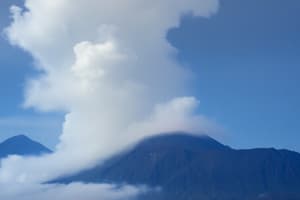Podcast
Questions and Answers
What type of volcano has broad, gentle slopes due to fluid lava flows?
What type of volcano has broad, gentle slopes due to fluid lava flows?
- Caldera volcano
- Cinder cone
- Shield volcano (correct)
- Stratovolcano
Which type of volcanic eruption releases large amounts of tephra and pyroclastic materials?
Which type of volcanic eruption releases large amounts of tephra and pyroclastic materials?
- Hawaiian eruption
- Plinian eruption (correct)
- Strombolian eruption
- Effusive eruption
Which hazard associated with volcanic activity involves mudflows?
Which hazard associated with volcanic activity involves mudflows?
- Ballistic projectiles
- Lava flows
- Pyroclastic density currents
- Lahars (correct)
What are small, steep-sided volcanoes formed by explosive eruptions that eject volcanic ash and lava fragments?
What are small, steep-sided volcanoes formed by explosive eruptions that eject volcanic ash and lava fragments?
What is the primary purpose of conducting regular surveys and analysis of seismicity, gas emissions, and other signs of unrest by scientists?
What is the primary purpose of conducting regular surveys and analysis of seismicity, gas emissions, and other signs of unrest by scientists?
Which type of magma produces slower, continuous eruptions called lava flows?
Which type of magma produces slower, continuous eruptions called lava flows?
Flashcards are hidden until you start studying
Study Notes
Volcanoes are geological formations where molten rock, ash, steam, and gas escape from beneath the Earth's surface, often resulting in dramatic natural events. There are three main types of volcanoes based on their shape and structure: shield volcanoes, stratovolcanoes, and cinder cones. Shield volcanoes have broad, gentle slopes due to fluid lava flows, while stratovolcanoes have steep sides with alternating layers of ash and lava. Cinder cones are small, steep-sided volcanoes formed by explosive eruptions that eject volcanic ash and lava fragments.
Volcanic eruptions occur when magma rises from deep within the Earth and reaches the surface through vents or fissures in the ground. These eruptions can be explosive or effusive, depending on the type of magma involved and the pressure under which it is released. Explosive eruptions release large amounts of tephra and pyroclastic materials, while more viscous magmas produce slower, continuous eruptions called lava flows.
The potential hazards associated with volcanic activity include lava flows, pyroclastic density currents, lahars (mudflows), ballistic projectiles, emissions of toxic gases, and changes in atmospheric circulation. Monitoring these hazards is crucial for predicting and mitigating volcanic risks, which is why scientists conduct regular surveys and analysis of seismicity, gas emissions, and other signs of unrest.
Despite their destructive potential, volcanoes also create unique landscapes and contribute significantly to our planet's ecosystems. For example, they generate fertile soils and minerals, influence weather patterns, and play a role in plate tectonics and global climate regulation. Understanding volcanology helps us appreciate the dynamic nature of our planet and prepare for future eruptive events.
Studying That Suits You
Use AI to generate personalized quizzes and flashcards to suit your learning preferences.




